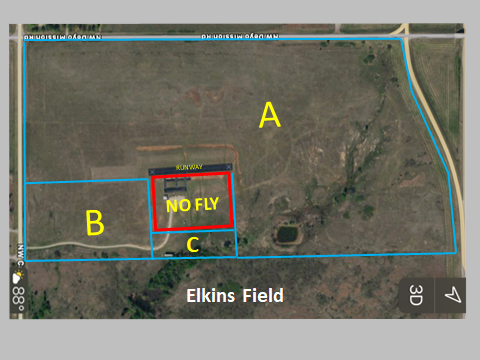Elkins Field Rules and Safety Guidelines
(Edition: 15 February 2022)
Field Rules & Safety Guidelines PDF file for download: Field Rules & Safety Guidelines
- Governance: All pilots must be members of the Academy of Model Aeronautics (AMA) and Lawton Area Fun Flyer Society (LAFFS) except for LAFFS’ guest pilots and non-AMA pilots enrolled in the AMA “Intro Pilot Program” under the direct supervision of an AMA-designated LAFFS instructor pilot. All pilots must be familiar with and comply with the AMA Safety Guide, FAA regulations, and Elkins Field Rules and Guidelines. (see http://www.modelaircraft.org). FPV pilots must comply with AMA document 550, Unmanned Aircraft Operations Utilizing First-person View. See: http://www.lawtonareafunflyers.org/blog/category/rules/
- Field Diagram:
Area A: for aircraft operating from the main runway.
Area B: Primarily for sailplanes, park flyers, small foamies, rotorcraft, and others that can’t safely integrate with aircraft operating from the main runway. Aircraft such as sailplanes, etc., climbing to higher altitudes and requiring more area may fly outside of Area B, but use caution not to conflict with aircraft in other areas.
Area C – Corridor: Transition corridor between Areas A and B in either direction. Located between the outhouse and the trailer. Only used in the late afternoon for downwind leg of the east-side traffic pattern when the low western sun prevents traffic patterns being flown safely to the west of the runway. Area C is not for maneuvering (aerobatics, turns, etc). Don’t fly traffic patterns to the east earlier in the day when the sun is high and the normal pattern to the west would be safe. Pilots must use extreme caution to avoid flying over the parking area and to avoid other aircraft operating in Areas A and B.
No-Fly Area: Do not takeoff from, fly approaches over, or land in the designated “No-Fly” area which includes the pit area, pilot boxes, and parking lot.
- Flight Pattern Flow: It is safest when all aircraft are flowing in the same general direction to avoid mid-air collisions. A recommendation is to fly the upwind leg relatively close to the runway and the downwind leg farthest from the runway in a general box pattern around the airfield. Aircraft can still do maneuvers, aerobatics, etc., if at the completion of the maneuver they resume travel that is not opposite the direction of other aircraft in their vicinity, if possible. Try to avoid cutting diagonally across the pattern, especially when there are several aircraft flying. If you plan to spin down through the pattern, a verbal announcement would help others know your intentions.
- Frequency Control: If not using a 2.4 GHz radio system, frequency control is the responsibility of each pilot. Non-2.4 GHz transmitters should have something clearly identifying their channel (frequency flag, channel number tag, etc.), preferably attached to the antenna.
- Pilot boxes: Once in the air, stand in the fenced pilot boxes or no closer to the runway than the pilot boxes. Do not stand on or near the runway.
- Verbal Announcements:
